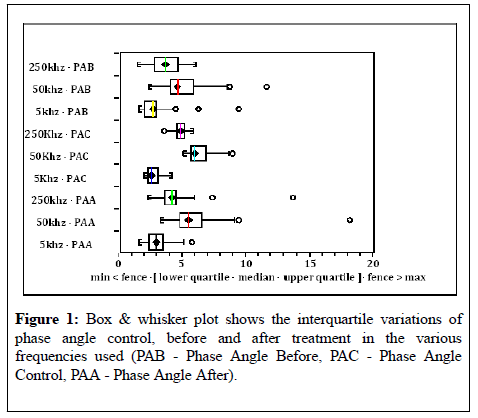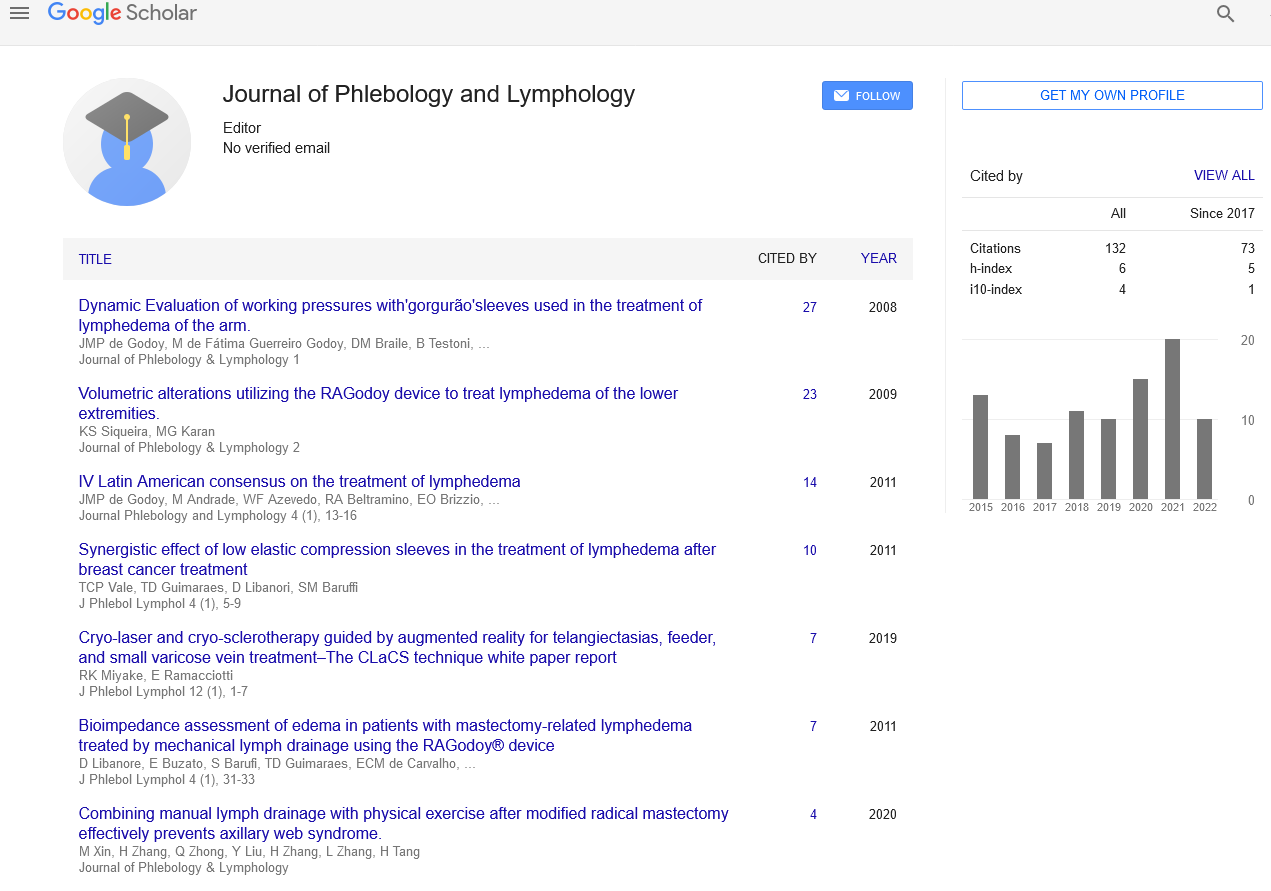Phase angle in the assessment of intensive outpatient treatment of primary lower limb lymphedema
2 Medicine School of São Jose do Rio Preto-FAMERP, Brazil
3 Universidade Federal do Mato Grosso Cuiabá, MT, SP, Brazil, Email: henriquegodoy95@gmail.com
4 Medicine School in São José do Rio Preto (FAMERP), Brazil, Email: ignacio@fclf.org
Received: 15-Sep-2017 Accepted Date: Oct 10, 2017; Published: 12-Oct-2017
Citation: Pereira de Godoy JM, Fortuny EL, Pereira de Godoy HJ, et al. Phase angle in the assessment of intensive outpatient treatment of primary lower limb lymphedema. J Phlebol Lymphol. 2017;10(1):12-15.
This open-access article is distributed under the terms of the Creative Commons Attribution Non-Commercial License (CC BY-NC) (http://creativecommons.org/licenses/by-nc/4.0/), which permits reuse, distribution and reproduction of the article, provided that the original work is properly cited and the reuse is restricted to noncommercial purposes. For commercial reuse, contact reprints@pulsus.com
Abstract
Introduction: Lymphedema is a clinical condition resulting from the accumulation of macromolecules in the interstitial space that leads to an accumulation of fluids. Objective: The aim of this study was to evaluate changes in the phase angle during the intensive treatment of primary lymphedema of the lower limbs. Methods: Using the phase angle of bio impedance, the intensive clinical treatment of primary lower limb lymphedema was evaluated at the ClÃnica Godoy in 2013 and 2014. The participants were 15 male and 40 female patients with a mean age of 40.43 years (range: 25-73; median: 37 years). Only patients with stage II and III primary lymphedema were included in this study; patients with stage I lymphedema and those with edema due to other causes were excluded. Diagnosis was based on patient history and physical examination. Patients were submitted to intensive treatment consisting of 8 hours/day of Mechanical Lymphatic Therapy – lymph drainage using an electromechanical device that performs ankle flexion and extension – together with 15 minutes of cervical stimulation and a grosgrain stocking alternated with elastic bandages as compression therapy. The phase angle was evaluated using the In Body S10 bio impedance apparatus before and after five days of treatment at frequencies of 5, 50 and 250 kHz. The Kruskal-Wallis and all pairwise comparisons (Conover-Inman) tests were used for statistical analysis with an alpha error of 5% being considered acceptable. Results: Significant improvements in the phase angle were detected at all frequencies (Kruskal-Wallis: p-value <0.005). Conclusion: The cellular pattern of lymph edematous limbs as evaluated by the phase angle of bio impedance improves with the treatment of lymphedema.
Keywords
Lymphedema, treatment, bio impedance, phase angle, Godoy & Godoy method
Introduction
Lymphedema is a clinical condition resulting from the accumulation of macromolecules in the interstitial space that leads to an accumulation of fluids. Lymphedema is characterized as primary when the patient is born with some alteration of the lymphatics and secondary when the patient’s lymphatic system is damaged during their lifetime [1].
Diagnosis is based on the patient’s clinical history and physical examination but when there is doubt, complementary examinations should be requested. Lymphoscintigraphy allows a functional and anatomical evaluation, but evaluations of the volume of the limb are necessary to confirm the condition of clinical lymphedema. Volumetry, perimetry and bioimpedance are commonly used for this evaluation [2,3].
A combination of therapies is recommended for the treatment of lymphedema allowing a faster result; however, isolated techniques are indicated in specific cases.
This combination generally includes Manual and Mechanical Lymphatic Therapy, compression and myolymphokinetic exercises and activities [4-7]. Intensive therapy in an outpatient setting has been described with this method producing reductions of around 50% of the volume of edema within five days [2].
Electrical bio impedance, by evaluating impedance, reactance and phase angle, is a method of assessing body composition and nutritional status. The phase angle is a clinically applicable method that reflects cell vitality and integrity with higher values indicating better preserved cell activity [8,9]. It is obtained from bio impedance and is derived from the ratio between the resistance (R) and reactance (Xc) [10-13]. The phase angle has been interpreted as an indicator of prognosis and a predictor of survival in some clinical situations [14].
The objective of this study was to evaluate the evolution of the phase angle during intensive treatment of primary lymphedema of the lower limbs.
Methods
The intensive clinical treatment of primary lower limb lymphedema was evaluated in 15 male and 40 female patients with a mean age of 40.43 years (range: 25-73; median: 37 years) at the Clínica Godoy in 2013 and 2014.
Only patients with primary stage II and III lymphedema were included in this study; patients with stage I lymphedema and those with edema due to other causes were excluded. All patients were included consecutively on arrival at the clinic for treatment. Diagnosis was based on patient history and physical examination.
Patients were submitted to intensive treatment consisting of 8 hours/day of Mechanical Lymphatic Therapy – lymph drainage using an electromechanical device (RAGodoy®) to perform ankle flexion and extension – together with 15 minutes of Cervical Stimulation Therapy and a grosgrain stocking alternated with elastic bandages as compression therapy.
Cervical Stimulation Therapy is a lymph drainage technique developed by Godoy & Godoy that uses stimulation of the cervical region. The phase angle was evaluated using the InBody S10 bio impedance apparatus before and after five days of treatment at frequencies of 5, 50 and 250 kHz.
The Kruskal-Wallis and all pairwise comparisons (Conover-Inman) tests were used for statistical analysis with an alpha error of 5% being considered acceptable. This study was approved by the Research Ethics Committee in of the Medicine School in São José do Rio Preto (# 019539/2014 / CAAE 27823014.8.0000.5415) and all participants signed written consent forms before being included in the study.
Results
Table 1 shows that there is an improvement of alpha angle parameters in all frequencies evaluated.
| variables | 5 Khz-before | 5 Khz-after | 5 Khz-normal | 50 Khz-before | 50 Khz-after | 50 Khz-normal | 250 Khz-before | 250 Khz-after | 250 Khz-normal |
|---|---|---|---|---|---|---|---|---|---|
| Valid data | 55 | 55 | 55 | 55 | 55 | 55 | 55 | 55 | 55 |
| Mean | 2,74 | 3,01 | 2,82 | 4,99 | 7,23 | 6,41 | 3,72 | 4,39 | 4,88 |
| Standard deviation | 1,31 | 0,79 | 0,64 | 1,62 | 9,52 | 1,06 | 1,13 | 1,62 | 0,57 |
| Variance coefficient | 0,47 | 0,26 | 0,22 | 0,32 | 1,31 | 0,16 | 0,30 | 0,37 | 0,11 |
| Upper quartile | 2,95 | 3,5 | 3,1 | 5,9 | 6,75 | 6,9 | 4,65 | 4,7 | 5,2 |
| median | 2,7 | 3,0 | 2,6 | 4,65 | 5,4 | 6 | 3,7 | 4,2 | 4,9 |
| Lower quartile | 2,05 | 2,4 | 2,3 | 4,1 | 4,85 | 5,7 | 2,8 | 3,5 | 4,6 |
Table 1: Shows the descriptive statistics of Phase Angle control, before and after intensive treatment of lower limb lymphedema for one week.
Significant improvements were detected (Kruskal-Wallis: p value <0.005) for all frequencies before and after intensive treatment (Table 2).
| Lower Limb Phase Angle | p-value | ||
| Before | After | ||
| 5 khz | P<0.0001 | ||
| 50 khz | P<0.0005 | ||
| 250 khz | P=0.002 | ||
Table 2: Statistical evaluation of phase angle variations before and after intensive treatment of primary lower limb lymphedema. Kruskal-Wallis: all pairwise comparisons (Conover-Inman), Critical t (756 df)=1.963107.
Figure 1 (Box & whisker plot) shows the interquartile variations of phase angle control, before and after treatment at the various frequencies used.
Discussion
The current study evaluated the phase angle of bio impedance during the intensive treatment of primary stage II and III lymphedema of the lower limbs and detected an improvement at all frequencies evaluated (5, 50 and 250 kHz). No study in the literature describes this evaluation. Even so, the phase angle has been used to assess prognosis in the evaluation of some inflammatory, infectious and neoplastic diseases correlating a good prognosis with a better phase angle [14-16].
Intensive treatment caused significant changes during the five days of treatment reducing the limb volume by about 50%. However, the edema was not completely reduced and the phase angle did not normalize. Complete reduction of the edema may be associated with an even better phase angle. Therefore, an evaluation of the phase angle may demonstrate the therapeutic evolution of these patients.
This study was performed in patients with primary lymphedema, however, a study currently being prepared for publication shows that lymph mobilization is different between primary and secondary leg lymphedema suggesting different patterns of the phase angle with the different therapeutic responses. Impedance and reactance data may also contribute to a better understanding of the evolution of lymphatic therapy. Therefore, this study created new opportunities for research in respect to the real importance of the phase angle in the diagnosis and evolution of lymphedema treatment.
Conclusion
The cellular pattern of lymph edematous limbs as evaluated using the phase angle of bio impedance improves with lymphedema treatment.
REFERENCES
- Lee BB, Antignani PL, Baroncelli TA, et al. Iua-Isvi consensus for diagnosis guideline of chronic lymphedema of the limbs. Int Angiol. 2015;34(4):311-32.
- Pereira De Godoy JM, Amador Franco Brigidio P, Buzato E, et al. Intensive outpatient treatment of elephantiasis. Int Angiol. 2012;31(5):494-9.
- Pereira De Godoy JM, Franco Brigidio PA, Salles Cunha SX, et al. Mobilization of fluids in large volumetric reductions during intensive treatment of leg lymphedema. Int Angiol. 2013;32(5):479-82.
- Lamprou DA, Damstra RJ, Partsch H. Prospective, randomized, controlled trial comparing a new two-component compression system with inelastic multicomponent compression bandages in the treatment of leg lymphedema. Dermatol Surg. 2011;37(7):985-91.
- De Godoy JM. Development and evaluation of a new apparatus for lymph drainage: preliminary results. Lymphology 2004;37(2):62-4.
- Belczak CE, de Godoy JM, Ramos RN, et al. Is the wearing of elastic stockings for half a day as effective as wearing them for the entire day? Br J Dermatol. 2010;162(1):42-5.
- Godoy JMP, Godoy MFG, Braile DM, et al. Dynamic evaluation of working pressures with gorgurão sleeves used in the treatment of lymphedema of the arm. Journal of Phlebology and Lymphology. 2008;1(1):5-7.
- Máttar JA. Application of total body bioimpedance to the critically ill patient. Brazilian Group for Bioimpedance Study. New Horiz. 1996;4(4):493-503.
- Norman K, Stobäus N, Pirlich M, et al. Bioelectrical phase angle and impedance vector analysis - clinical relevance and applicability of impedance parameters. Clin Nutr. 2012;31(6):854-61.
- Cornish BH, Bunce IH, Ward LC, et al. Bioelectrical impedance for monitoring the efficacy of lymphoedema treatment programmes. Breast Cancer Res Treat. 1996;38:169–76.
- Cornish BH, Thomas BJ, Ward LC, et al. A new technique for the quantification of peripheral edema with application in both unilateral and bilateral cases. Angiology. 2002;53: 41–7.
- Hayes S, Janda M, Cornish B, et al. Lymphedema secondary to breast cancer: how choice of measure influences diagnosis, prevalence, and identifiable risk factors. Lymphology 2008;41:18–28.
- Ward LC. Bioelectrical impedance analysis: proven utility in lymphedema risk assessment and therapeutic monitoring. Lymphatic Res Biol. 2006;4:51–6.
- Gupta D, Lis CG, Dahlk SL, et al. Bioelectrical impedance phase angle as a prognostic indicator in advanced pancreatic cancer. British Journal of Nutrition 2004;92(6):957-962.
- Hui D, Bansal S, Morgado M, et al. Phase angle for prognostication of survival in patients with advanced cancer: preliminary findings.Cancer. 2014;120(14):2207-14.
- Akimoto M, Nakamura M, Mukumoto N, et al. Optimization of the x-ray monitoring angle for creating a correlation model between internal and external respiratory signals.Med Phys. 2012;39(10):6309-15.






